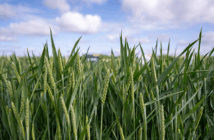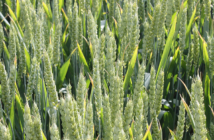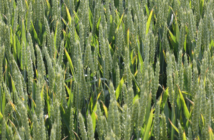Effective integrated weed management starts with cultural controls to reduce the size of the weed seedbank. But once the crop is drilled, the herbicide programme takes centre stage with residual herbicides at pre-em. and follow up applications. Diversity is key. Use different actives within the programme to improve control and manage resistance.
“Each active has unique characteristics. Consider mode of action (MoA), root or shoot activity, and longevity to build a balanced herbicide programme that copes with variable conditions to deliver high levels of control,” says Bayer Technical Manager Rachel Banks.
Start strong
“An effective pre-em. sets the standard for the season so it’s important to start strong. Metribuzin co-forms like Alternator® Met, Octavian® and Cadou® Met contain three different MoAs with root and shoot activity. Adding Proclus® provides a fourth MoA, improving control and adding longevity into the programme. Also, it is less reliant on soil moisture for efficacy than many other actives so it will be even more valuable this autumn if dry conditions continue,” explains Rachel.
This combination of proven herbicides offers excellent control of black grass, Italian rye-grass and brome species with the flexibility to follow up with more chemistry in the toughest situations.
Graph1: Excellent Italian rye-grass control
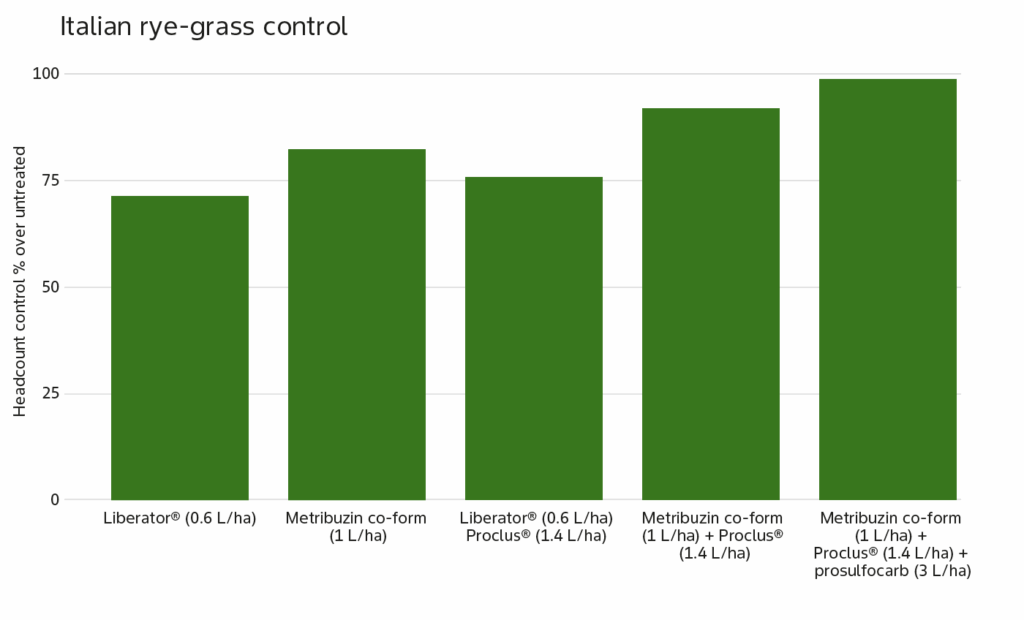
Bayer contracted trials x3 (2022-23) – Pre-em applied autumn 2022. Average untreated count = 110m2
Graph 2: Good black-grass control – use in a tight sequence with other chemistry for maximum effect
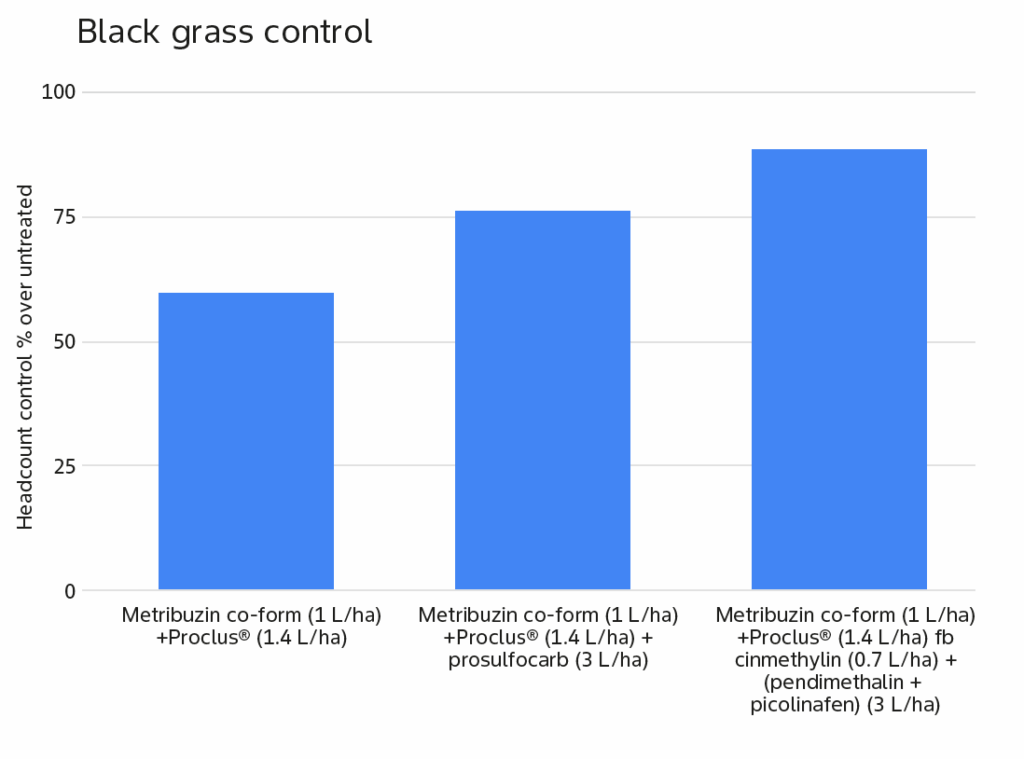
Bayer contracted trials x4 (2022-23) – Pre-em + sequence applied autumn 2022. Average untreated count = 270m2
What is a MoA?
The MoA is the chemical basis for how a herbicide kills a weed. Different herbicides can have the same MoA. For example, prosulfocarb, tri-allate and flufenacet all inhibit cells from making very long-chain fatty acids, disrupting cell division. They’re all in the Herbicide Resistance Action Committee (HRAC) Group 15. In contrast diflufenican is in Group 12 as it inhibits an enzyme phytoene desaturase, which is important in photosynthesis.
For autumn, there six different MoAs available for the residual programme; HRAC Groups 3, 5, 12, 15, 30, 32. We can also use contact-acting chemistry after weed emergence, Atlantis® OD contains mesosulfuron + iodosulfuron, both from HRAC Group 2.
For resistance management, use actives from different HRAC MoA groups and avoid using any active in the programme more than once.
How MoA diversity improves control
“Bayer has done trials in conjunction with NIAB to measure the benefit of more MoAs in the programme. Normally trials look at products at full rate, which is how farmers use them and what we generally recommend for resistance management.
“But these trials don’t easily show if control is thanks to diverse MoA or just the effect of applying more herbicide in total. The trial with NIAB was designed to split out these two variables.”
Two years of trials showed that MoA diversity improved efficacy. The effect was more pronounced in Italian rye-grass than black grass. In practical terms it means that mode of action diversity is not just about long-term stewardship but about better short-term control too. In addition to chemical controls, cultural controls also stack together to increase efficacy.
The starting point was an untreated September drilled crop. Next, higher seed rates were tested, then October drilling and higher seed rates. Shifting to October drilling had a huge impact on overall control. On top of cultural controls, a single active programme was compared to diverse modes of action. Control from the diverse programme was far superior.
Graph 3: Stacking controls for Italian rye-grass control
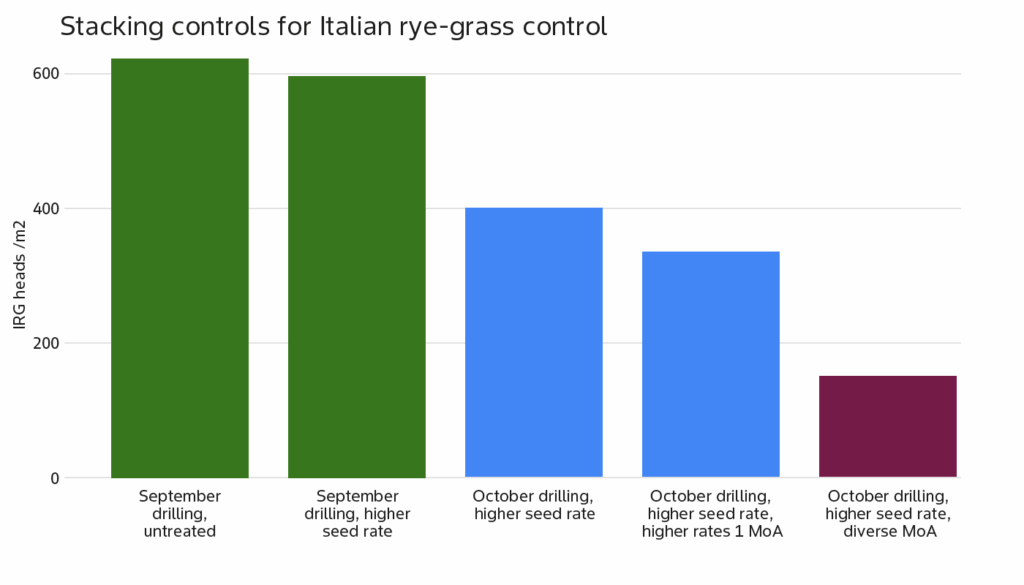
Source: NIAB Faversham (Kent) trial site Italian Rye-grass 2023
Root or shoot activity
The most effective herbicide programmes have a combination of root and shoot activity to attack weeds in different ways.
Herbicides like flufenacet, metribuzin and cinmethylin are more soluble and move through the soil for uptake by the roots of germinating weeds. Make sure there is sufficient soil moisture and a good quality seedbed without impermeable barriers for these actives to perform at their best.
Proclus® and diflufenican are not mobile, they remain at the soil surface. Weeds take in these herbicides as the shoots emerge out of the soil. Less reliant on soil moisture for efficacy, aim for consistent coverage across the field to form a protective layer on the surface. A fine, firm seedbed free of clods helps with this.
Protection throughout autumn
“The pre-em. controls weeds which germinate due to disturbance from drilling. But further germination is a problem too, earlier drilled crops and Italian rye-grass are situations where continued protection is very important.” Says Rachel.
Each active degrades at a different rate so it controls germinating weeds for different lengths of time. Be sure to include herbicides with good longevity like Proclus® in the programme.
In general, all actives degrade more quickly in warm and moist conditions. Herbicides applied later in autumn, after delayed drilling for example, have better longevity because of cooler weather.
Topping up is another way to build in more protection. A second or even third herbicide application controls subsequent weed germination. If expecting protracted germination of Italian rye-grass, plan to come back 2–4 weeks after the pre-em.
“For black grass, we normally recommend a short gap of 1–2 weeks for any follow up spray because black grass germination is far more concentrated around early / mid-October.”
Safe application – best practice
Root acting herbicides can affect crops too. Drilling depth and quality is very important to keep herbicides away from crop roots.
- Drill crops consistently to at least 32 mm.
- Make sure slots are closed with no exposed seed
- Avoid applications when heavy rain is forecast because it can wash herbicides into the crop rooting zone.
- Be cautious on lighter soils; herbicides move through them more easily
- Applying herbicides in sequence is safer than a large tank-mix.
Alternator® Met contains metribuzin, flufenacet and diflufenican. Atlantis® OD contains mesosulfuron and iodosulfuron. Cadou® Met contains flufenacet, diflufenican and metribuzin. Liberator® contains flufenacet and diflufenican. Octavian® Met contains metribuzin, flufenacet and diflufenican. Proclus® contains aclonifen. Alternator®, Atlantis®, Cadou®, Octavian®, Proclus® and Liberator® are Registered Trademarks of Bayer. All other brand names used are Trademarks of other manufacturers in which proprietary rights may exist. Use plant protection products safely. Always read the label and product information before use. Pay attention to the risk indications and follow the safety precautions on the label. For further information, including contact details, visit www.cropscience.bayer.co.uk or call 0808 1969522. © Bayer Crop Science Limited 2025.
About Bayer
Bayer is a global enterprise with core competencies in the life science fields of health care and nutrition. In line with its mission, “Health for all, Hunger for none,” the company’s products and services are designed to help people, and the planet thrive by supporting efforts to master the major challenges presented by a growing and aging global population. Bayer is committed to driving sustainable development and generating a positive impact with its businesses. At the same time, the Group aims to increase its earning power and create value through innovation and growth. The Bayer brand stands for trust, reliability and quality throughout the world. In fiscal 2024, the Group employed around 93,000 people and had sales of 46.6 billion euros. R&D expenses amounted to 6.2 billion euros. For more information, go to www.bayer.com.
Forward-Looking Statements
This release may contain forward-looking statements based on current assumptions and forecasts made by Bayer management. Various known and unknown risks, uncertainties and other factors could lead to material differences between the actual future results, financial situation, development or performance of the company and the estimates given here. These factors include those discussed in Bayer’s public reports which are available on the Bayer website at www.bayer.com. The company assumes no liability whatsoever to update these forward-looking statements or to conform them to future events or developments.


